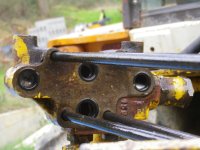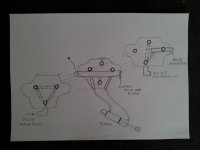martini64
New member
I have an old backhoe, which through my rough use, has stopped working. I have been using it for years until at full depth I hit a large rock.
The pressure blew the pump, but I think also the valve I describe below. I have replaced the pump and a piston which got bent, but it is not working.
I am pretty certain this one-way check valve (maybe also a relief valve?) is now not doing its job, and is the issue. It controls the pressure and return flow of the oil (I think!).
But, I am not certain how it goes together and so is supposed to work. It fits as a cartridge in the end section of the manifold taking the return line oil in.
It needs to let the oil through itself so that it can come out of the manifold and return to the reservoir, but I don't know how this is supposed to be done.
The main cartridge has a conical plug fixed in it. The plug screws on to the cartridge with the spring inside pushing another conical plug against the one in the cartridge.
This seems to stop the flow completely, as there is a rubber "o" ring on the cartridge to stop oil passage on outside. I don't know the function of the plunger.
The attached photo shows the bits, but it is possible I have lost a piece as is spring loaded and shot out in disassembly.
Any help would be greatly appreciated.
The pressure blew the pump, but I think also the valve I describe below. I have replaced the pump and a piston which got bent, but it is not working.
I am pretty certain this one-way check valve (maybe also a relief valve?) is now not doing its job, and is the issue. It controls the pressure and return flow of the oil (I think!).
But, I am not certain how it goes together and so is supposed to work. It fits as a cartridge in the end section of the manifold taking the return line oil in.
It needs to let the oil through itself so that it can come out of the manifold and return to the reservoir, but I don't know how this is supposed to be done.
The main cartridge has a conical plug fixed in it. The plug screws on to the cartridge with the spring inside pushing another conical plug against the one in the cartridge.
This seems to stop the flow completely, as there is a rubber "o" ring on the cartridge to stop oil passage on outside. I don't know the function of the plunger.
The attached photo shows the bits, but it is possible I have lost a piece as is spring loaded and shot out in disassembly.
Any help would be greatly appreciated.



